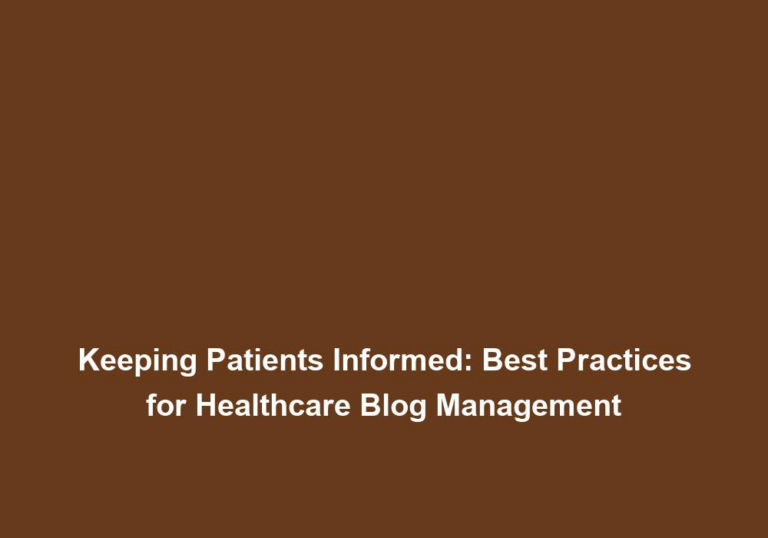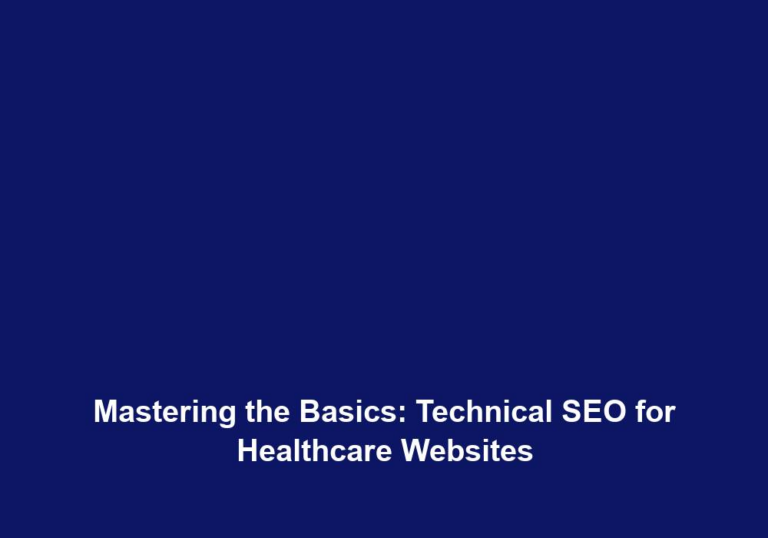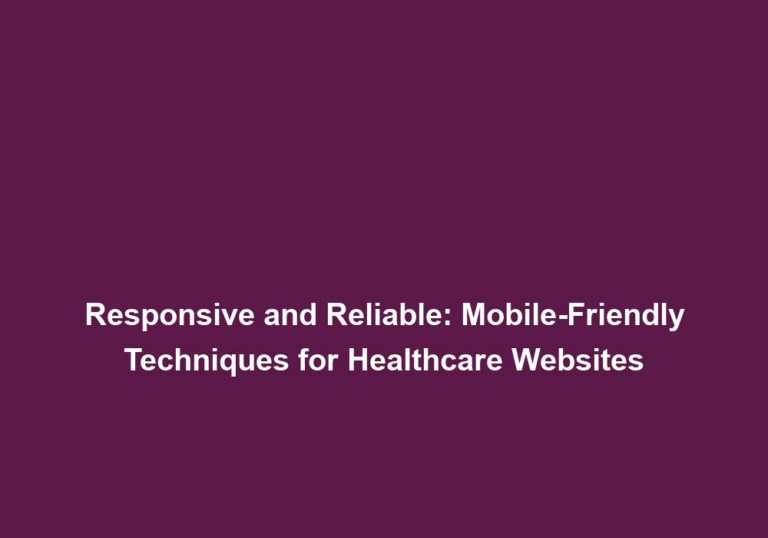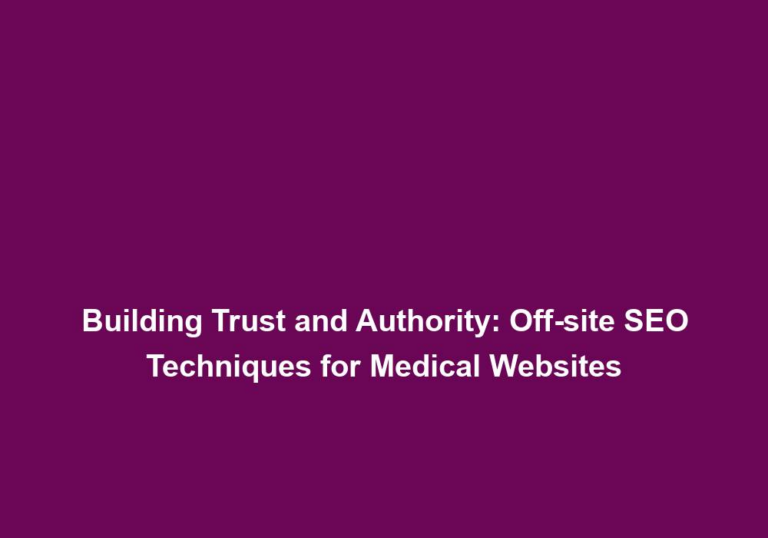On-site SEO for Healthcare Websites: A Comprehensive Guide
In today’s digital era, having a strong online presence is crucial for healthcare websites. With the increasing number of people turning to the internet for healthcare information, it’s essential for healthcare providers to optimize their websites for search engines. This comprehensive guide will explore various on-site SEO strategies specifically tailored for healthcare websites.
1. Keyword Research
Keyword research forms the foundation of any successful SEO strategy. It involves identifying the key phrases and terms that potential patients are likely to search for. For healthcare websites, it’s important to focus on both general and medical-specific keywords.
To begin your keyword research, start by brainstorming common healthcare topics and services related to your practice. Consider the conditions you treat, the services you offer, and any specialties you have. Tools like Google Keyword Planner can help you understand the search volume and competition for these keywords.
When selecting keywords, aim for those that have high search volume and low competition. This will maximize your website’s visibility in search engine results. Create a list of target keywords to use throughout your website, including in your content, title tags, and meta descriptions.
2. Title Tags and Meta Descriptions
Title tags and meta descriptions are HTML elements that provide concise information about a webpage’s content. Optimizing these elements is crucial for improving your website’s click-through rate (CTR) and search engine ranking.
Title Tags
When creating title tags, include your target keywords while keeping them concise and compelling. For example: “Comprehensive Healthcare Services | Your Medical Practice Name.” This title tag not only includes the target keyword “healthcare services” but also provides a clear description of the practice.
Meta Descriptions
Write persuasive meta descriptions that summarize the content of the page. Incorporate relevant keywords and include a call-to-action to encourage users to click through. For example: “Discover our comprehensive healthcare services designed to optimize your wellness. Contact us today to schedule an appointment!”
Remember, title tags and meta descriptions should accurately represent the content of the page and entice users to click. Avoid keyword stuffing and ensure that each title tag and meta description is unique.
3. URL Structure
Having a clean and user-friendly URL structure benefits both website visitors and search engines. Consider the following best practices when structuring your healthcare website’s URLs:
-
Use descriptive and readable URLs that include relevant keywords. For example: “yourmedicalpractice.com/services/primary-care” is more effective than “yourmedicalpractice.com/page1234.”
-
Avoid using special characters, symbols, or excessive numbers in your URLs, as they can confuse both search engines and users.
-
Implement a logical hierarchy for your URLs to help search engines understand the structure of your website. For instance, use subdirectories to organize different sections of your website, such as “/services” or “/blog.”
By following these URL best practices, you enhance your website’s usability and make it easier for search engines to crawl and index your pages.
4. Header Tags and Content Optimization
Header tags (H1, H2, H3, etc.) play a crucial role in organizing and prioritizing your website’s content. They also provide search engines with additional information about the page’s content.
H1 Tag
The H1 tag represents the main heading of the page and should include the target keyword or a variation of it. For example: “Comprehensive Healthcare Services for Optimal Wellness.” This H1 tag clearly communicates the main topic of the page and includes the target keyword “healthcare services.”
H2 and H3 Tags
Utilize subheadings (H2 and H3 tags) to break down your content into sections. Include relevant keywords in these subheadings to help search engines understand the context of the content. For example:
H2: Preventive Care Services
- Provide an overview of the preventive care services offered at your medical practice.
- Explain the importance of preventive care in maintaining overall health.
- Highlight the benefits of regular check-ups and screenings.
H3: Vaccinations
- Discuss the importance of vaccinations in preventing diseases.
- Provide information on common vaccines and their benefits.
- Address any concerns or misconceptions about vaccinations.
Content Optimization
Create high-quality, informative, and engaging content that focuses on your target keywords. Incorporate the keywords naturally throughout the content to avoid keyword stuffing. Use bullet points, numbered lists, and relevant images to enhance readability and user experience.
When developing content, consider the questions and concerns of your target audience. Provide valuable information that addresses their needs and interests. By offering valuable content, you not only improve your website’s SEO but also establish your authority and trustworthiness in the healthcare industry.
5. Mobile Optimization
In today’s mobile-first world, optimizing your healthcare website for mobile devices is essential. Here are some tips to ensure your website is mobile-friendly:
-
Use a responsive design that automatically adjusts your website’s layout and content based on the user’s device. This ensures a seamless experience across different screen sizes.
-
Optimize your images and multimedia elements to reduce loading times on mobile devices. Compress images without compromising quality and consider using lazy loading techniques.
-
Ensure that your website’s font sizes, buttons, and links are easily clickable and accessible on mobile devices. Avoid small font sizes and ensure sufficient spacing between interactive elements.
-
Test your website’s mobile-friendliness using tools like Google’s Mobile-Friendly Test and make necessary optimizations based on the results. Address any issues with page loading, content rendering, or usability.
By prioritizing mobile optimization, you provide a positive user experience for mobile users and improve your website’s visibility in mobile search results.
6. Page Speed Optimization
Page speed is a crucial factor that affects both user experience and search engine rankings. Here are some tips to improve your healthcare website’s page speed:
-
Optimize and compress images to reduce file sizes without compromising image quality. Use appropriate image formats (such as JPEG or PNG) and consider lazy loading techniques.
-
Minify CSS, JavaScript, and HTML files to reduce their file sizes. Remove unnecessary spaces, comments, and code to improve loading times.
-
Enable browser caching to store certain elements of your website on the user’s device, reducing load times for subsequent visits. Set appropriate cache expiration periods to ensure updated content is displayed.
-
Use a content delivery network (CDN) to distribute your website’s content across multiple servers globally, minimizing latency. This ensures faster delivery of your web pages to users, regardless of their geographical location.
By implementing these page speed optimization techniques, you provide a faster and smoother browsing experience for your website visitors, leading to higher user satisfaction and improved search engine rankings.
7. Schema Markup
Schema markup is a code that allows search engines to better understand and display your website’s content in search results. Incorporating schema markup can enhance your website’s visibility and attract more qualified traffic.
Consider implementing schema markup for the following elements:
-
Your healthcare practice’s contact information, including address, phone number, and business hours. This helps search engines display accurate contact details in search results.
-
Medical services offered, such as primary care, specialist consultations, or diagnostic tests. This allows search engines to highlight the specific services you provide.
-
Healthcare professional profiles, including their qualifications, specialties, and experience. This showcases your medical team’s expertise and helps patients make informed decisions.
-
Patient reviews and ratings, showcasing your practice’s reputation and credibility. Positive reviews and high ratings can influence potential patients’ decision-making process.
By implementing schema markup, you provide search engines with structured data, enabling them to display rich snippets and improve the visibility and relevance of your website in search results.
Conclusion
Implementing on-site SEO strategies is essential for healthcare websites looking to improve their online visibility and attract more patients. By conducting thorough keyword research, optimizing title tags, meta descriptions, and URLs, creating well-structured content, and ensuring mobile optimization, page speed, and schema markup, you can enhance your website’s search engine rankings and drive organic traffic. Regularly monitor and analyze your website’s performance using tools like Google Analytics to make necessary adjustments and stay ahead in the competitive healthcare industry.







